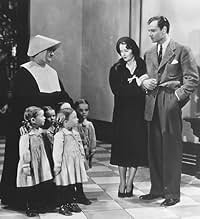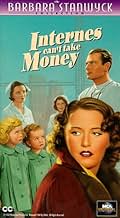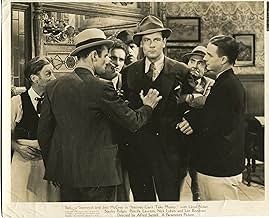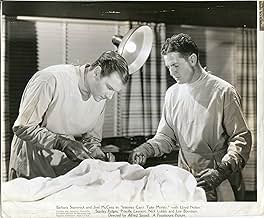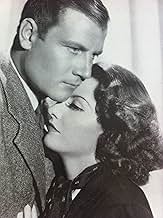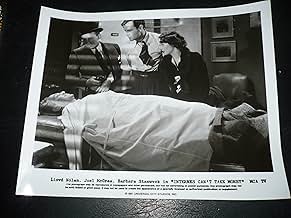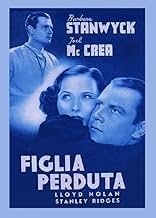- Awards
- 1 win total
Steve Pendleton
- Interne Jones
- (as Gaylord Pendleton)
James Adamson
- Porter
- (uncredited)
Agostino Borgato
- Popcorn Vendor
- (uncredited)
Helen Brown
- Nurse
- (uncredited)
- Director
- Writers
- All cast & crew
- Production, box office & more at IMDbPro
Featured reviews
A wildly improbable drama, the misspelled "Internes Can't Take Money" was the first in the "Dr.Kildare" movie series, which was subsequently recast with Lew Ayres in the title role and continued at the MGM studio, following this initial Paramount effort. Concocted by writer Max Brand, the story involves an honest young intern at a large hospital, who crosses paths with a widowed ex-con seeking to locate her three-year-old daughter, who was abducted by her deceased bank-robber husband. The recipe is an old one; toss in a couple of shady characters and a gangster with a heart of gold, who is embroiled in illegal betting, add a tolerant landlady and a kindly bartender, sprinkle with nuns, mix with unexpected twists, and bake until overdone.
Despite an uninspired title and a routine script, director Alfred Santell maintains a steady pace that will distract viewers from the at-times laughable plot turns that lead to a teary fade-out, provoked either by laughter or sentiment. Beyond the script, the film's technical aspects are quite good, especially the black and white cinematography by Theodor Sparkuhl, who often dramatically captures Stanwyck garbed in deep black, contrasting with McCrea, dressed in his intern's whites.
Barbara Stanwyck plays the widow, Janet Haley, and the actress, at her sudsy distraught-mother best, is convincing in an unconvincing role. Joel McCrea is the original Dr. Kildare, a straight-arrow intern, poorly paid and burdened by work and rules, who seeks solace at a nearby bar, where his life takes a sudden turn. Stanwyck and McCrea, in their third co-starring film, work well together, and Stanwyck seems genuinely taken with McCrea during their first scene together. Attesting to what makes a film star a star, Stanwyck and McCrea add dimension and interest to otherwise cardboard characters in credibility-stretching situations. In addition to the two stars, the capable cast also includes Lloyd Nolan, Stanley Ridges, and Charles Lane. However, if not for the professionalism and charisma of the leads and supporting players, "Internes Can't Take Money" would be 80 minutes of laughable coincidences and plot turns, memorable only as the first in the Dr. Kildare movie series.
Despite an uninspired title and a routine script, director Alfred Santell maintains a steady pace that will distract viewers from the at-times laughable plot turns that lead to a teary fade-out, provoked either by laughter or sentiment. Beyond the script, the film's technical aspects are quite good, especially the black and white cinematography by Theodor Sparkuhl, who often dramatically captures Stanwyck garbed in deep black, contrasting with McCrea, dressed in his intern's whites.
Barbara Stanwyck plays the widow, Janet Haley, and the actress, at her sudsy distraught-mother best, is convincing in an unconvincing role. Joel McCrea is the original Dr. Kildare, a straight-arrow intern, poorly paid and burdened by work and rules, who seeks solace at a nearby bar, where his life takes a sudden turn. Stanwyck and McCrea, in their third co-starring film, work well together, and Stanwyck seems genuinely taken with McCrea during their first scene together. Attesting to what makes a film star a star, Stanwyck and McCrea add dimension and interest to otherwise cardboard characters in credibility-stretching situations. In addition to the two stars, the capable cast also includes Lloyd Nolan, Stanley Ridges, and Charles Lane. However, if not for the professionalism and charisma of the leads and supporting players, "Internes Can't Take Money" would be 80 minutes of laughable coincidences and plot turns, memorable only as the first in the Dr. Kildare movie series.
"Internes Can't Take Money" is the first Dr. Kildare movie and unlike the long string of Dr. Kildare/Dr. Gillespie movies from MGM, this Paramount film has an entirely different cast, style and, in some cases, characters. It's really odd when you've seen the MGM films...and I think it's best to see the movie without trying to compare it to the later series.
While Joel MacCrea plays Dr. Kildare, in this case he's NOT a doctor right out of medical school but a full-fledged doctor at the hospital. And, there also is no cranky/avuncular Dr. Gillespie as his mentor.
While Kildare is a major character, the story seem to revolve more around Janet (Barbara Stanwyck)...a woman just out of prison whose baby was stolen from her by her rat of a husband. The husband is now dead and she has no idea where to find the girl. So, she spends much of the film looking in vain for the kid...and nice Dr. Kildare eventually helps her with this task...along with some significant help from a mobster (Lloyd Nolan)!
The style of this film is nothing like the later Kildare films and it's less a hospital movie and more a crime film. As such, it's enjoyable and well acted...though the story is, at times, a bit hard to believe. Still, it is worth seeing.
While Joel MacCrea plays Dr. Kildare, in this case he's NOT a doctor right out of medical school but a full-fledged doctor at the hospital. And, there also is no cranky/avuncular Dr. Gillespie as his mentor.
While Kildare is a major character, the story seem to revolve more around Janet (Barbara Stanwyck)...a woman just out of prison whose baby was stolen from her by her rat of a husband. The husband is now dead and she has no idea where to find the girl. So, she spends much of the film looking in vain for the kid...and nice Dr. Kildare eventually helps her with this task...along with some significant help from a mobster (Lloyd Nolan)!
The style of this film is nothing like the later Kildare films and it's less a hospital movie and more a crime film. As such, it's enjoyable and well acted...though the story is, at times, a bit hard to believe. Still, it is worth seeing.
The first appearance of young James Kildare, MD was in this Paramount feature that starred Joel McCrea as the young Intern at Blair General Hospital. Come to think of it, I don't recall if the name of the hospital is given in the film.
Nor will you find any of the other regulars from the Kildare/Gillespie series from MGM. When Paramount saw no possibilities in a series of films, they didn't do film series with the exception of Hopalong Cassidy, MGM picked it up.
Lew Ayres who was Kildare over at MGM was a bright idealistic getting his minting over at Blair General Hospital under the tutelage of gruff but kindly Lionel Barrymore. McCrea is a more stern type of Kildare, the most straight arrow of straight arrows. In fact Joel McCrea was quoted as saying he never felt comfortable being anything other than the straight arrow hero. But he was good in those parts.
His patients include Barbara Stanwyck, a woman from the wrong side of the tracks who will do anything to get back the child she lost custody of and Lloyd Nolan who he patches up after a brawl in the bar they both frequent. Both of their stories intertwine and you see the film to learn how.
In what was essentially a B programmer Paramount gave a lot of good production values to this film. I guess it was befitting the stars McCrea and Stanwyck who were definitely on their way up.
I do sort of miss the Blair General Hospital regulars, but McCrea does right by the character of James Kildare, MD.
Nor will you find any of the other regulars from the Kildare/Gillespie series from MGM. When Paramount saw no possibilities in a series of films, they didn't do film series with the exception of Hopalong Cassidy, MGM picked it up.
Lew Ayres who was Kildare over at MGM was a bright idealistic getting his minting over at Blair General Hospital under the tutelage of gruff but kindly Lionel Barrymore. McCrea is a more stern type of Kildare, the most straight arrow of straight arrows. In fact Joel McCrea was quoted as saying he never felt comfortable being anything other than the straight arrow hero. But he was good in those parts.
His patients include Barbara Stanwyck, a woman from the wrong side of the tracks who will do anything to get back the child she lost custody of and Lloyd Nolan who he patches up after a brawl in the bar they both frequent. Both of their stories intertwine and you see the film to learn how.
In what was essentially a B programmer Paramount gave a lot of good production values to this film. I guess it was befitting the stars McCrea and Stanwyck who were definitely on their way up.
I do sort of miss the Blair General Hospital regulars, but McCrea does right by the character of James Kildare, MD.
... except this one is from Paramount and stars Joel McCrea as Dr. James Kildare. Like in the MGM series starting the following year, Dr. Kildare is an intern in a large New York City hospital, he lives on subsistence wages, and has a pretty grueling schedule. Unlike the MGM series there is no hot tempered wheelchair bound mentor in the person of one Dr. Gillespie. In all of his judgements here, Kildare is pretty much on his own.
As an intern in the hospital, Kildare treats a young woman for a burn on her hand (Barbara Stanwyck as Janet Haley). She also turns out to be undernourished so Kildare makes her lie down and drink a glass of milk. He then discharges her. It turns out Janet does have a job, she's just been cutting corners including her own meals to save money to pay for stool pigeons to help her find her own three year old child. She had been stolen by her estranged husband to keep her quiet about his illegal activities, but he died after pulling a hold up before he could tell her where the child was. She spent two years in prison because everybody believed she was in on the robbery with her husband.
If this is starting to sound like it is mainly about Stanwyck's character and not so much about Kildare, you would be right. This is mainly Stanwyck's film. But Kildare does figure heavily into helping Janet solve her dilemma. Also figuring heavily into the plot is Kildare's big taste for risk if it helps somebody out. That includes sewing up a gangster (Lloyd Nolan) after he shows up at a cafe and bar near the hospital, stabbed in some underworld activity and requiring immediate medical attention.
I think I prefer Lew Ayres' interpretation of the role, but this film is still worthwhile.
As an intern in the hospital, Kildare treats a young woman for a burn on her hand (Barbara Stanwyck as Janet Haley). She also turns out to be undernourished so Kildare makes her lie down and drink a glass of milk. He then discharges her. It turns out Janet does have a job, she's just been cutting corners including her own meals to save money to pay for stool pigeons to help her find her own three year old child. She had been stolen by her estranged husband to keep her quiet about his illegal activities, but he died after pulling a hold up before he could tell her where the child was. She spent two years in prison because everybody believed she was in on the robbery with her husband.
If this is starting to sound like it is mainly about Stanwyck's character and not so much about Kildare, you would be right. This is mainly Stanwyck's film. But Kildare does figure heavily into helping Janet solve her dilemma. Also figuring heavily into the plot is Kildare's big taste for risk if it helps somebody out. That includes sewing up a gangster (Lloyd Nolan) after he shows up at a cafe and bar near the hospital, stabbed in some underworld activity and requiring immediate medical attention.
I think I prefer Lew Ayres' interpretation of the role, but this film is still worthwhile.
An exceptionally flavorful rendering of the Depression atmosphere: a world of the poor laboring in sweatshop jobs, petty hoods hanging out in smoky bars, backroom bookie joints, pushcart vendors and bus terminals and orphanages. While the plot is no more ambitious than the typical B movie of the time, the high production values, name cast, and imaginative direction from Alfred Santell all boost the quality.
At the center of the plot, Barbara Stanwyck spends much of the film in desperation mode, exhausted from searching for her lost child, beaten down by two years in jail, forced to hire stool pigeons, forced to stay alert.
Joel McCrea makes the ideal American hero for the 30's: not only a doctor, but tall, blond, honest, sincere, manly, and progressive. At one point, he has to perform an operation on a bar room table, improvising with violin strings, an ice pick, and a bottle of rum! But this is not MGM's Dr. Kildare. He has no warm relationship with a kindly old mentor; instead, the chief doctor is an authority figure upholding the rules, dismissing Lee Bowman for unauthorized experimentation. The script also pumps up sympathy for interns as underpaid workers who get only $10 a month.
As a gangster, the always fascinating Stanley Ridges conveys the calm of a man secure in his power, whose eye movements size up his adversaries and whose silences reveal more menace than mere words. Watch the sexual innuendo he finds in his "I didn't always like popcorn" speech.
Santell uses extreme close-ups and moves the camera often, aided by gleaming lighting from Theodore Sparkuhl, plus some knock-out sets, including a sparkling white Art Deco clinic and an elaborately detailed New York Irish bar. Watch how economically Santell works to show the awakening of mutual attraction between Stanwyck and McCrea in their first scene together. Also lifting the picture out of its formula origins is the headlong pace Santell maintains to the climax, an urgency lost in the blander MGM series.
At the center of the plot, Barbara Stanwyck spends much of the film in desperation mode, exhausted from searching for her lost child, beaten down by two years in jail, forced to hire stool pigeons, forced to stay alert.
Joel McCrea makes the ideal American hero for the 30's: not only a doctor, but tall, blond, honest, sincere, manly, and progressive. At one point, he has to perform an operation on a bar room table, improvising with violin strings, an ice pick, and a bottle of rum! But this is not MGM's Dr. Kildare. He has no warm relationship with a kindly old mentor; instead, the chief doctor is an authority figure upholding the rules, dismissing Lee Bowman for unauthorized experimentation. The script also pumps up sympathy for interns as underpaid workers who get only $10 a month.
As a gangster, the always fascinating Stanley Ridges conveys the calm of a man secure in his power, whose eye movements size up his adversaries and whose silences reveal more menace than mere words. Watch the sexual innuendo he finds in his "I didn't always like popcorn" speech.
Santell uses extreme close-ups and moves the camera often, aided by gleaming lighting from Theodore Sparkuhl, plus some knock-out sets, including a sparkling white Art Deco clinic and an elaborately detailed New York Irish bar. Watch how economically Santell works to show the awakening of mutual attraction between Stanwyck and McCrea in their first scene together. Also lifting the picture out of its formula origins is the headlong pace Santell maintains to the climax, an urgency lost in the blander MGM series.
Did you know
- TriviaBarbara Stanwyck asked director Al Santell to cast Joel McCrea as her leading man, having worked with him twice before. "I want this guy," she told him. "He's going to be a good leading man."
- GoofsDuring the bar-room conversation (c.16 minutes) the coffee cup on the table disappears, re-appears and moves between shots.
- Quotes
Bookie: Maybe it's the cops.
"Chief" Hanlon: Cops don't knock, they break in.
- ConnectionsFollowed by Le Jeune Docteur Kildare (1938)
- How long is Internes Can't Take Money?Powered by Alexa
Details
- Release date
- Country of origin
- Language
- Also known as
- Internes Can't Take Money
- Filming locations
- Manhattan, New York City, New York, USA(Second unit opening credits)
- Production company
- See more company credits at IMDbPro
- Runtime1 hour 18 minutes
- Color
- Aspect ratio
- 1.37 : 1
Contribute to this page
Suggest an edit or add missing content


